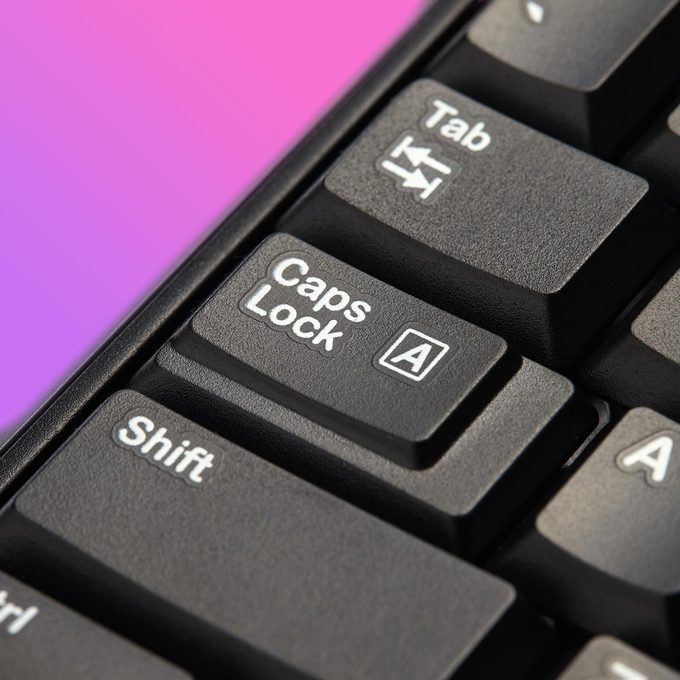Gen Z is canceling capital letters—should you join them or fight in grammar's last stand?

Here’s Why Capital Letters May Soon Be a Thing of the Past

As a mother of four, I’ve learned to just nod and pretend I understand Gen Z slang—no cap, frfr. So when they stopped using capital letters and punctuation, I shrugged and figured it was another skibidi toilet thing. That is, until I had to help edit their school essays. Then I wanted to scream. Why were they so averse to the basic conventions of grammar? Why would they use text speak in formal essays? And—while we’re on the topic—why do they bypass the dishwasher and leave dirty dishes in the sink? Teens, amiright?
Apparently, I’m not the only elder millennial baffled by Gen Z’s creative approach to grammar. In fact, it’s a whole trend, says generational researcher Jason Dorsey, a business etiquette expert, the president of the Center for Generational Kinetics and the author of Zconomy: How Gen Z Will Change the Future of Business. “There’s definitely a trend where Gen Z eschews traditional grammar in written communications,” he says. “We see this particularly in how they have dropped using capital letters and punctuation.”
The moment he said this, I flashed back to a conversation with my 15-year-old daughter. She had just sent me a short text with no capitals and no punctuation. It felt abrupt and a little aggressive. “Your text is so short. Are you mad at me??” I asked her.
Her reply: “Why do you put exclamation points and question marks all over your texts? You don’t need them. It looks weird, especially when you do like three in a row.”
First of all, how dare she! Second, as an older millennial, I firmly believe that multiple exclamation points show enthusiasm!!! But Dorsey reassured me that this is normal. “Language is fluid, and conventions change all the time as societal norms evolve,” he says.
OK, fine. But why this? Or, as Gen Z would say: but why this
Read on to discover why Gen Z hates capital letters, how this affects the workplace and what to do when you receive a text that looks like a ransom note from a very chill kidnapper.
Get Reader’s Digest’s Read Up newsletter for more news, humor, travel, tech and fun facts all week long.
What does Gen Z have against capital letters?

According to Dorsey, Gen Z’s aversion to capital letters comes down to two main factors: the rise of casual, social media–driven communication and a decline in emphasis on traditional writing skills in schools.
But why are we just asking Dorsey, a fellow millennial? I decided to go straight to the source: my Gen Z kids and their friends.
- Sam, 23: “I don’t bother capitalizing names, places, acronyms or other proper nouns. The meaning of the words doesn’t really change if the letters are capitalized or not. So why bother with the effort?”
- Micah, 18: “It’s not that deep. It’s just easier.”
- Artemis, 19: “No one uses them, so I don’t either. I guess I’m just a follower.”
- Summer, 17: “Capitals feel like you’re trying to be formal or fake. Like you’re overthinking what you’re saying. It doesn’t feel authentic.”
- Beaux, 20: “I go for whatever is easiest. I don’t type capitals, but my phone autocorrects them, and it’s too much work to go back and make them little again. But if my phone doesn’t fix it, I’m not taking the extra step to hit the up arrow on the keyboard.”
- Jonas, 21: “no u” (writer’s note: ?!?)
None of these responses surprise branding expert Scott Baradell, CEO of the marketing firm Idea Grove and author of the book Trust Signals: Brand Building in a Post-Truth World. “Yes, this trend has been growing for years,” he says. “Gen Z often favors lowercase text in both personal communication and branding because it feels more casual, authentic and conversational. It aligns with the way they text and communicate on platforms like TikTok and Instagram, where lowercase has become a visual cue for informality and relatability.”
How common is this lack of capital letters?
We can’t say precisely how many people—or how many Gen Zers—stick to lowercase letters. But the trend of ditching capitals has been picking up steam, especially among younger people.
It’s not just a texting thing anymore. It’s everywhere, from social media to branding and even some workplaces in creative industries. It’s part of a bigger shift toward more relaxed and natural ways of writing, moving away from old-school grammar rules, Baradell says.
Brands jumping on the lowercase bandwagon
It’s not a new phenomenon for brands to use lowercase logos to appear more friendly and casual, Baradell says. One example is the energy giant BP’s switch to a lowercase company logo back in 2000 as part of its bid to appear more approachable and eco-conscious.
“But it’s fair to say the move toward lowercase has ramped up to appeal to Gen Z’s aesthetic,” he says. “Over the past couple of years, companies like GM, Docusign and others have rebranded with lowercase logos as part of their identity. The lowercase style signals a less ‘corporate’ feel, which resonates with younger audiences who value authenticity over formality.”
Plenty of other companies have caught on to this trend and are using all-lowercase branding to vibe with Gen Z. Take hair-care company Amika: It uses lowercase on its packaging to feel more chill and approachable. Spotify keeps things casual too, giving its playlists names like “chill vibes” and “teen beats.”
Companies like these are ditching capitals to seem more relatable and in touch with the way Gen Z communicates, Baradell says. With each lowercase letter, the brand is essentially saying, “Hey, we’re cool.” Sorry: “hey we’re cool”
Brands bypassing the trend
Baradell notes that while this approach works well for lifestyle, beauty and tech brands, it may not be suitable for industries that rely on trust and authority, such as finance and health care. “The key is understanding your audience—if your brand wants to connect with Gen Z in a relaxed, social-first way, lowercase can be a smart choice,” he says. “If credibility and professionalism are priorities, a more traditional approach may be better.”
How should you respond if you get a text without any capital letters?

It depends on the context and communication medium, Dorsey says. “Overall, I don’t really see this as a problem. If people want to be very casual on Slack or texting, it’s not a big deal,” he says. “It becomes an issue, however, in the workplace, where employers generally expect people to use professional communication.”
It’s gotten so bad that it’s causing rifts with older generations in work settings. They sometimes see this as evidence that Gen Z is “lazy,” “sloppy” or “not smart.”
“These stereotypes aren’t true,” Dorsey adds. “This is just evidence of the norms changing, as they always do over time.”
So what should you do if you receive a text, email or other message without capital letters? It might initially seem informal or even disrespectful if you’re accustomed to traditional grammar rules. But it’s essential to understand the intent behind this style—Gen Z’s use of lowercase is often a way to create a relaxed and friendly tone. Following their lead can improve communication. Use these tips from our experts when responding:
- Go with the flow: If they text in all lowercase, you can match their vibe. It keeps the conversation feeling natural and chill.
- Stick to your style: Not a fan of the lowercase life? No problem. If using proper capitalization makes you feel more like yourself, keep doing you.
- Ask, if you’re confused: If their lack of capitals makes a message unclear (or you’re worried they’re mad at you), just ask. It’s better to check than to overthink it.
At the end of the day, it’s all about understanding one another—whether that means going full lowercase, ALL CAPS or somewhere in between.
The next question we olds often wonder is: Should you correct a Gen Zer’s incorrect grammar? If you’re their parent or teacher and they’re still on the young side, then yes, go ahead and talk to them about the appropriate times to be casual and when they should use formal communication, Dorsey says. But otherwise, it’s rude to correct other adults, and you likely can understand what they mean anyhow.
The one exception to this rule, he says, is if you’re managing a Gen Z in the workplace. “I would point out to them that you expect professional grammar to be used when communicating with clients and co-workers,” he says. “Using correct grammar makes a good impression and shows attention to detail.”
The surprising way Gen Z is changing communication norms
One way to avoid the no-capitals debate entirely? Ditch written text altogether, which is exactly what Gen Z and Gen Alpha are doing, says Dorsey.
“One of the biggest shifts we’re seeing is the move to voice memos and short videos (like Snapchat) instead of texting or emails,” he explains. That means no capitals, no punctuation—just straight-up talking (kind of).
Don’t assume this means they love talking in general. “A lot of Gen Z absolutely hate talking on the phone,” Dorsey adds. “Many will ignore calls and text back instead. They don’t like being put on the spot and prefer having time to think through their response, which they say voice memos and videos allow them to do.”
This shift, Dorsey says, could change communication even more than the whole lowercase trend. So where’s it all headed? “Over time, casual conversational styles will be the norm everywhere,” he predicts. “But for now, even as business communication becomes more relaxed, we’re not losing capital letters entirely.”
About the experts
|
Why trust us
Reader’s Digest has published hundreds of etiquette stories that help readers navigate communication in a changing world. We regularly cover topics such as the best messages to send for any occasion, polite habits that aren’t as polite as they seem, email and texting etiquette, business etiquette, tipping etiquette, travel etiquette and more. We’re committed to producing high-quality content by writers with expertise and experience in their field in consultation with relevant, qualified experts. We rely on reputable primary sources, including government and professional organizations and academic institutions as well as our writers’ personal experiences where appropriate. We verify all facts and data, back them with credible sourcing and revisit them over time to ensure they remain accurate and up to date. For this piece on lowercase letters, Charlotte Hilton Andersen tapped her experience as a longtime journalist who specializes in etiquette and communication for Reader’s Digest. Read more about our team, our contributors and our editorial policies.
Sources:
- Jason Dorsey, business etiquette expert, generational researcher, president of the Center for Generational Kinetics and author of Zconomy: How Gen Z Will Change the Future of Business; phone interview, Feb. 26, 2025
- Scott Baradell, branding expert, CEO of Idea Grove and author of Trust Signals: Brand Building in a Post-Truth World; email interview, Feb. 26, 2025



